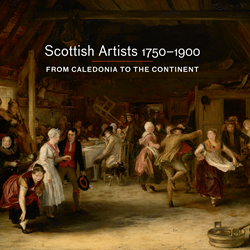
Scottish Artists
A collection of works by Scottish Artists collected by British monarchs from George III to the present day.
ALLAN RAMSAY (1713-84)
Queen Charlotte (1744-1818) with her two Eldest Sons
c.1764-9Oil on canvas | 247.8 x 165.0 cm (support, canvas/panel/str external) | RCIN 404922
Ramsay was brought to the attention of the royal family by one of his most important patrons, John Stuart, 3rd Earl of Bute, who in 1758 commissioned a portrait of George III when Prince of Wales, a version of which is in the Royal Collection (409153). Through an error John Shackleton (who died in 1767) was reappointed to the post of Principal Painter in Ordinary to George III on his accession in 1760. Ramsay, however, was given the title ‘one of His Majesty’s Principal Painters in Ordinary’ and assumed the duties of the King’s painter. The strength of Ramsay’s position in the King’s household is illustrated by George III’s refusal of Lord Eglinton’s request that he sit to Ramsay’s younger rival, Reynolds, with the words: ‘Mr Ramsay is my painter, my Lord.’ Lord Bute also introduced Johan Zoffany (1733-1810) to the King, but whereas Zoffany was at the outset of his career, Allan Ramsay was already fifty when he found himself superintending the productions of innumerable copies of his state portraits of the King and Queen (OM 996-7, 405307-8). This means that beyond these there are disappointingly few original portrait compositions by him in the collection – this painting and three individual portraits of standard three-quarter-length format (50 x 40 inches) of members of her family (OM 999-1001, 404924, 406963 and 403553).
This is the closest any British artist gets to the elegance, subtlety and precision of French portraiture and the best candidate to represent portrait painting in the Age of Enlightenment. The sitter is shown seated at an English spinnet (which may be compared with one at the Royal College of Museum of c. 1750 made by John Hitchcock); on the instrument is a work-box and a copy of John Locke’s 'Some Thoughts Concerning Education' (1693); leaning against it is a port-folio of drawings. The Queen holds Prince Frederick, later Duke of York (1763-1827); at her knee stands Prince George, Prince of Wales (later George IV, 1762-1830), with a bow and behind him a drum. Both boys are wearing dresses as they are too young to have yet been breeched.
Interestingly, the three sitters are painted on three separate pieces of canvas which have been joined together. It is possible that this was because the young Prince George grew and changed so quickly during the course of the commission that Ramsay was forced to alter the composition towards the end.
This is the closest any British artist gets to the elegance, subtlety and precision of French portraiture and the best candidate to represent portrait painting in the Age of Enlightenment. The sitter is shown seated at an English spinnet (which may be compared with one at the Royal College of Museum of c. 1750 made by John Hitchcock); on the instrument is a work-box and a copy of John Locke’s 'Some Thoughts Concerning Education' (1693); leaning against it is a port-folio of drawings. The Queen holds Prince Frederick, later Duke of York (1763-1827); at her knee stands Prince George, Prince of Wales (later George IV, 1762-1830), with a bow and behind him a drum. Both boys are wearing dresses as they are too young to have yet been breeched.
Interestingly, the three sitters are painted on three separate pieces of canvas which have been joined together. It is possible that this was because the young Prince George grew and changed so quickly during the course of the commission that Ramsay was forced to alter the composition towards the end.







